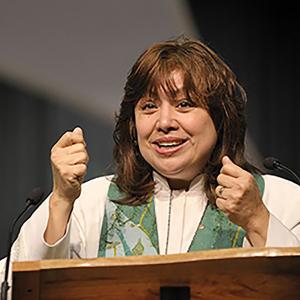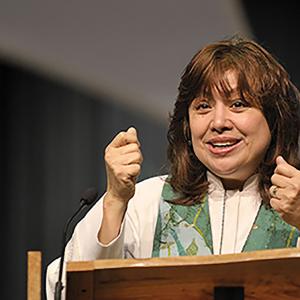
Maria-Pia Negro Chin is a bilingual multimedia journalist who freelances in New York.
Posts By This Author
¡Justicia! - en Español
Cómo es que líderes cristianos latinos están transformando lo que la iglesia entiende sobre la justicia social.
Click here to read this article in English.
AUNQUE ERA EL CUARTO mejor en su clase en la escuela secundaria, a Juan Martínez nunca lo impulsaron a tomar clases avanzadas o a pensar en ir a la universidad. Se había dado por hecho que trabajaría en el campo, como muchos otros latinos en California en la década de 1970.
Sin embargo, Martínez, quien es rector del Seminario Teológico Fuller en Pasadena, California, tenía otro llamado. Continuó sus estudios y fue pastor de la Iglesia Hermanos Menonitas. Actualmente tiene dos maestrías y un doctorado, si bien Martínez reconoce que su padre, quien también fuera pastor, fue el que le enseñó cómo ser ministro en la comunidad latina.
Desde niño Martínez observó como su padre ayudaba a familias separadas por redadas migratorias, apoyaba a trabajadores que sufrían explotación y marchaba al lado de otros líderes de Kettleman City, California, para protestar por un terreno lleno de desechos tóxicos, abierto sin informar a los trabajadores inmigrantes que vivía en la localidad. Sin embargo, el padre de Martínez nunca pensó que trabajara buscando “justicia social”, un término que él asociaba con iglesias que minimizaban la moral y salvación personal. Para su padre, según Martínez, el enfrentarse a las injusticias que afectaban a su congregación era simplemente “parte de la vida diaria de la iglesia”.
Al igual que su padre, el ministerio de Martínez como pastor latino lo hace lidiar con las realidades de su congregación, incluyendo la difícil situación de los migrantes. Sin embargo, a diferencia de su padre, a Martínez no le molesta la etiqueta de “justicia social” porque cree que la iglesia existe para la transformación de la comunidad y la conversión personal.
“No puedes ser un pastor latino y no trabajar con los indocumentados, ni tratar el tema del sistema educativo, ni discutir los salarios en zonas urbanas o rurales”, expresa Martínez. “Es algo presente cada día y tenemos que enfrentar las consecuencias”. Lo que está empezando a cambiar, añade Martínez, es que una nueva generación de líderes latinos y latinas están usando “un vocabulario de justicia social” para llamar la atención a los problemas que están enfrentando sus comunidades.
¡Justicia! - in English
How Latina and Latino Christian leaders are reshaping the church's understanding of social justice.
ALTHOUGH FOURTH in his high school class, Juan Martínez was never encouraged to take an AP exam or think about college. Like many other Latinos in California during the 1970s, it was assumed he would become a farm worker.
But Martínez, now vice president for diversity and international ministries at Fuller Theological Seminary in Pasadena, Calif., had a different calling; he continued his education and became a Mennonite Brethren pastor. He’s now earned two master’s degrees and a Ph.D. in theology, but Martínez still credits his father, also a pastor, for teaching him how to minister in the Latino community.
As a child, Martínez watched his father help families broken by immigration raids, support manual laborers facing exploitation, and march with other leaders in Kettleman City, Calif., to protest an enormous toxic waste dump that was created without informing the migrant workers who lived nearby. Yet Martínez’s father never considered his work “social justice,” a term he associated with churches that downplayed morality and personal salvation. For his father, said Martínez, addressing injustice against his congregation was simply “part of the daily life of the church.”
Like his father, Martínez’s ministry as a Latino pastor has involved dealing with the realities of his congregation, including the plight of migrants. But unlike his father, Martínez does not mind the label “social justice” because he believes the church exists for both community transformation and personal conversion.
“You cannot be a Latino pastor and not address the undocumented, not address the school system, not address salaries in urban or rural environments,” said Martínez. “It hits you in the face every day and we have to address the consequences.” What’s starting to change, Martínez explained, is that a new generation of Latino and Latina leaders are using “social justice vocabulary” to call attention to the problems facing their communities.
One in the Lord
A look at three multiracial churches—and how they got that way.
MULTIRACIAL CHURCHES are becoming more common in this country—but that doesn’t happen by chance.
A 2010 study by the Hartford Institute for Religion Research, based on a random sample of more than 11,000 congregations, revealed an increase in multiracial congregations in the U.S.—30 percent of churches reported that more than half of their members were part of minority groups.
Members of three multiracial churches in and near the nation’s capital—one Catholic, one Methodist, and one nondenominational—say that at their church “people don’t look the same, or think that much about it,” and describe their congregations as welcoming places “where you can feel God’s presence, where you can be yourself.”
Though Sunday worship time is still known as “the most segregated hour in America,” older members of churches such as Peace Fellowship Church in Washington, D.C., St. Camillus Catholic Church in Silver Spring, Md., and Culmore United Methodist Church in Falls Church, Va., remember when things started changing. As migration and demographic shifts altered neighborhoods and communities, members sought to engage in “desegregated” worship, opting to join communities that mirrored a world with different cultures and ways to praise God.

